

Clinical care pathway: Structured patient care for greater quality and efficiency
.
A clinical pathway is an indispensable tool in modern healthcare. It serves the structured planning, management, and documentation of treatment processes and enables standardized care for patients with defined diagnoses. This guide explains what a clinical pathway is, its advantages, and how visual pathways can improve communication. It also explains how the DIALOGBILD agency supports you in creating such pathways.
What is a clinical pathway?
A clinical pathway is a flow chart that maps a patient's entire treatment process from diagnosis to discharge. It is based on medical guidelines and best practices and contains quality indicators that enable regular review and adjustment
Care Pathway Definition
A care pathway describes the sequence of measures required to care for a patient. Timeframes, responsibilities, and content are clearly defined. The goal is to improve the quality of care, minimize risks, and use resources efficiently.
Structure of a Clinical Care Pathway
A typical clinical care pathway contains the following elements:
- Sequence of interventions: Diagnosis, therapy, nursing, and follow-up.
- Timeline: Scheduling of individual steps.
- Content: Detailed description of the interventions to be performed.
- Responsibilities: Clear assignment of tasks to physicians, nurses, and other stakeholders.
In addition, the chronological progression is often visualized on a timeline to ensure a clear representation of the process.
Advantages of a Clinical Care Pathway
Implementing a clinical care pathway offers numerous advantages:
- Improved quality: Standardized processes ensure consistent care.
- Efficiency: Clear structures save time and resources.
- Transparency: Patients receive a clear overview of their treatment process.
- Risk minimization: Uniform standards reduce sources of error.
- Cost reduction: Shorter hospital stays and optimized processes reduce costs.
Visual Care Pathways: A useful addition
Visual care pathways graphically represent the treatment process and offer additional advantages over text-based pathways. They are particularly helpful for:
- New employees: Clear visualizations facilitate onboarding.
- Consultations: Patients can better understand the course of treatment.
- Coordination: All involved can see at a glance who is responsible for which tasks.
- Patient communication: Anxiety is reduced because patients know exactly what to expect.
- Increased efficiency: Optimized processes enable patients to recover faster.
How does DIALOGBILD support the creation of visual treatment pathways?
The DIALOGBILD agency specializes in vividly visualizing complex medical processes. With its expertise, you can have customized visual treatment pathways created that are perfectly tailored to your needs.
DIALOGBILD Services
- Individual customization: DIALOGBILD creates customized visualizations with up to 20 process steps.
- Fast implementation: You will receive your print-quality dialog picture within two weeks.
- Extensive image database: With over 10,000 scenes, virtually all medical situations can be represented.
- Cross-media use: The visualizations can be used both digitally and in print.
Benefits for your facility
- New employees can be trained more quickly.
- Consultations are more efficient.
- The quality of your treatments is noticeably improved.
- Coordination between departments is improved.
- Patients feel safer and better informed.
- The recovery process is accelerated, reducing the burden on caregivers.
Steps to Implementing a Clinical Care Pathway
Introducing a clinical or visual care pathway requires careful planning:
1.) Analyze existing processes: Identify potential for optimization.
2.) Involve all stakeholders: Physicians, nurses, and therapists should be involved in the development process.
3.) Integrate guidelines: Use current medical standards as a basis.
4.) Staff training: Ensure that all employees understand and can apply the pathway.
5.) Regular evaluation: Review the pathway's success and make adjustments as needed.
Implementation Challenges
Despite their advantages, there are also challenges:
- Creating a pathway is time-consuming.
- Hospitals often lack digital infrastructure.
- Some staff may perceive the pathways as a restriction of their autonomy.
DIALOGBILD helps you overcome these challenges by creating simple and understandable visualizations that are easily accessible to both staff and patients.
Conclusion
A clinical pathway is a valuable tool for improving the quality of care in healthcare. Visual pathways also offer additional benefits such as better communication, reduced patient anxiety, and more efficient processes. With the support of DIALOGBILD, you can develop customized solutions that are perfectly tailored to your facility.
Take advantage of the possibilities of modern pathways – for structured care, satisfied patients, and optimized workflows!
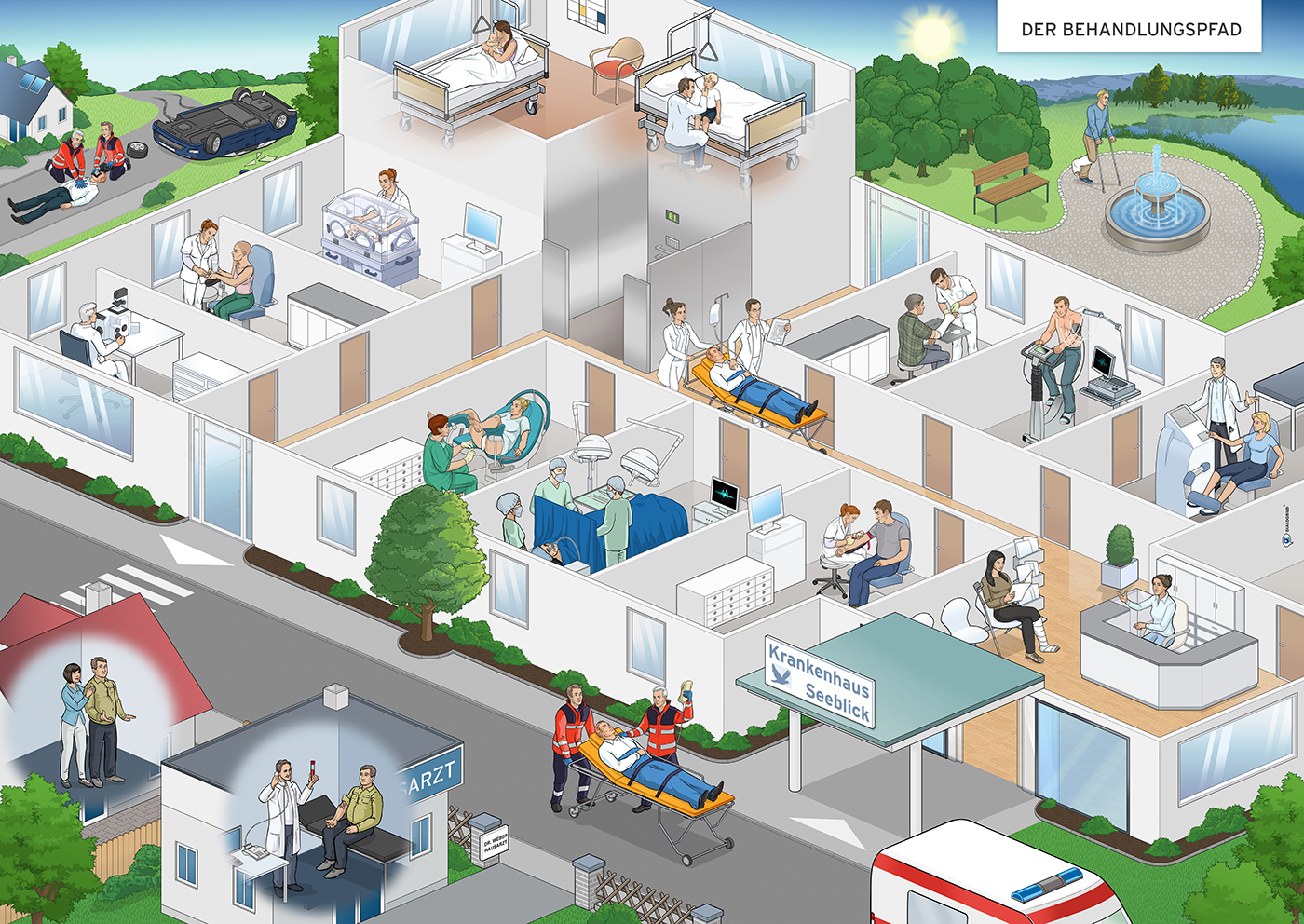
"TREATMENT PATH" CONSTRUCTION KIT
Every surgery, every treatment, raises a multitude of questions for the patient. What should I be aware of before the procedure, what will happen to me during the surgery, what risks are there, and will I experience pain after the anesthesia? Will my life even change?
No treatment process is complete without a consultation – from childbirth to heart surgery to chemotherapy. But how do you structure this process? What information will stick with your patient? ...
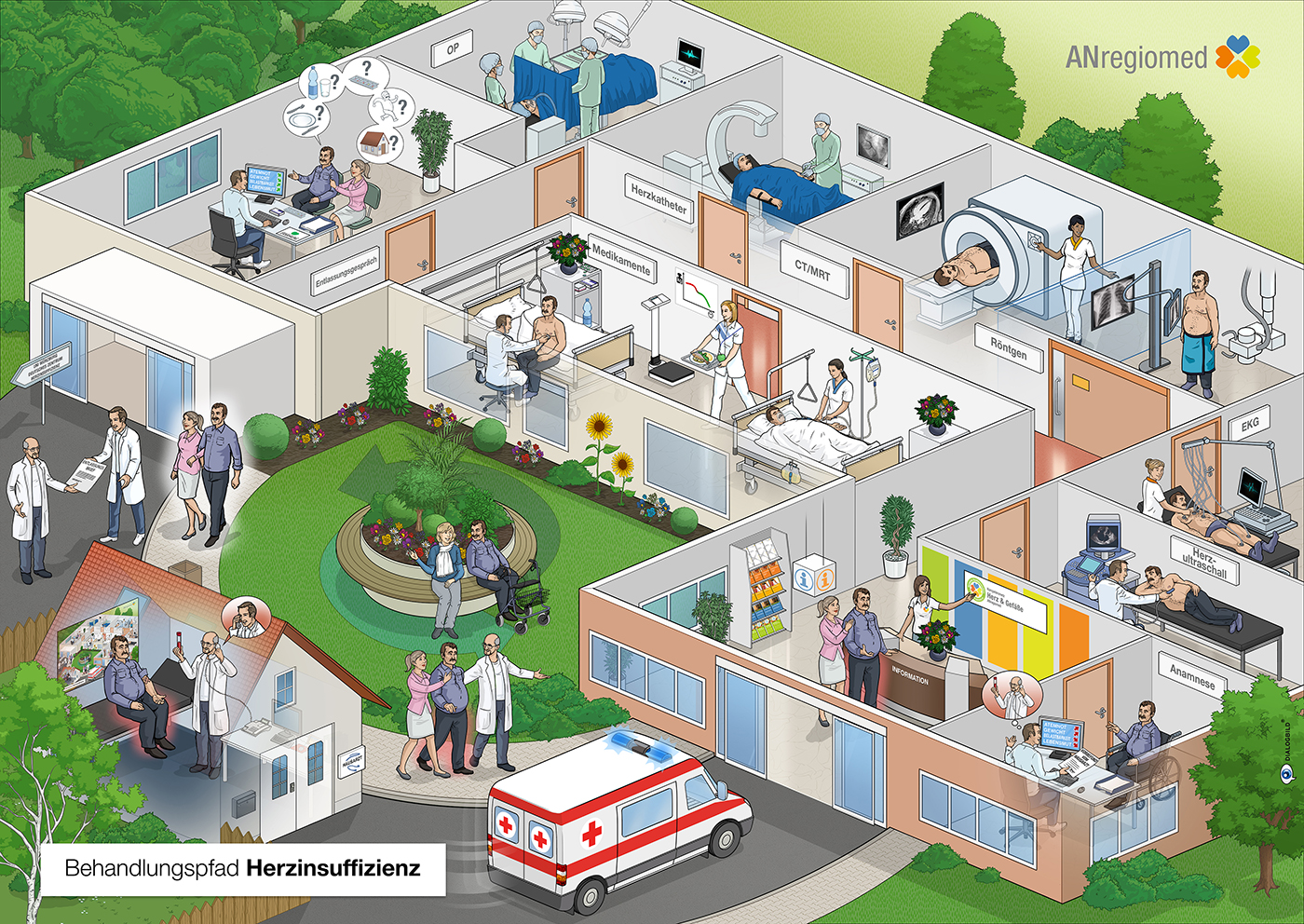
TREATMENT PATH
CARDIAC INSUFFICIENCY
ANregiomed is an association of the clinics Ansbach, Dinkelsbühl, Rothenburg and the Praxisklinik Feuchtwangen. A total of 813 beds are available for the treatment of acute-care patients. In the major departments and the specialist departments, approximately 2,500 employees work to provide for 40,000 acute-care patients each year. In addition, there are several thousand outpatient surgeries. Following the motto "competence with service and charm", the association ensures the health care in the city and county Ansbach. ...
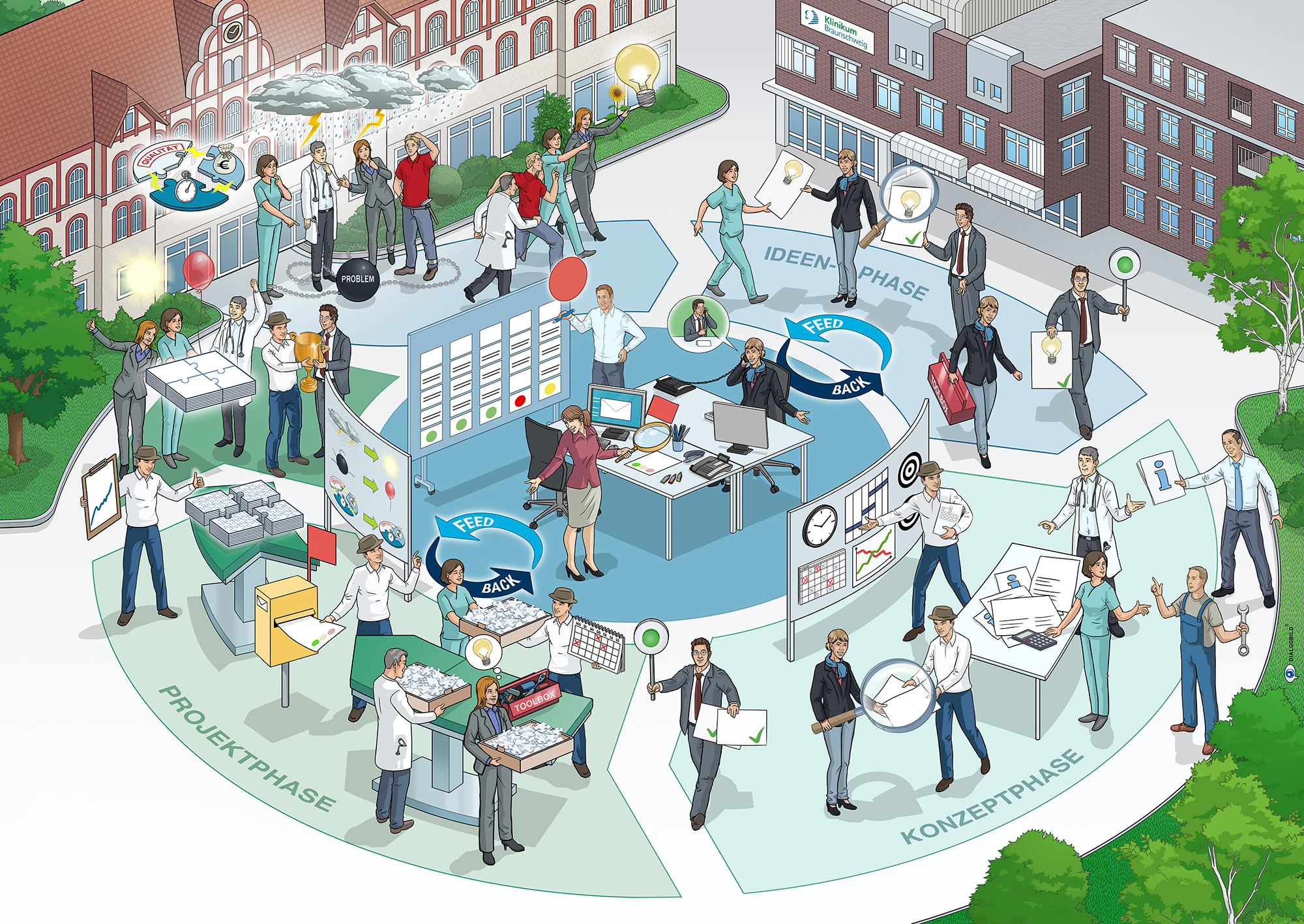
PROCESS VISUALISATION
CENTRAL PROJECT MANAGEMENT
The medical centre Braunschweig provides maximum care for the area Braunschweig and is one of the biggest hospitals in Germany with its 1,428 total beds. By having 19 medical centres, 10 independent clinical departments and 6 institutions, the medical centre Braunschweig covers almost the whole range of subjects the medical science holds. Each year more than 58,000 patients will receive inpatient treatment and 150,000 outpatient treatment.
All relevant workflows and processes are illustrated in demonstrative scenes for all project participants. After the formalisation of all documents about project management we discussed all steps included in the process flow with an interdisciplinary team in workshops and developed ideas of illustrations which have been visualised by the team of DIALOGBILD.
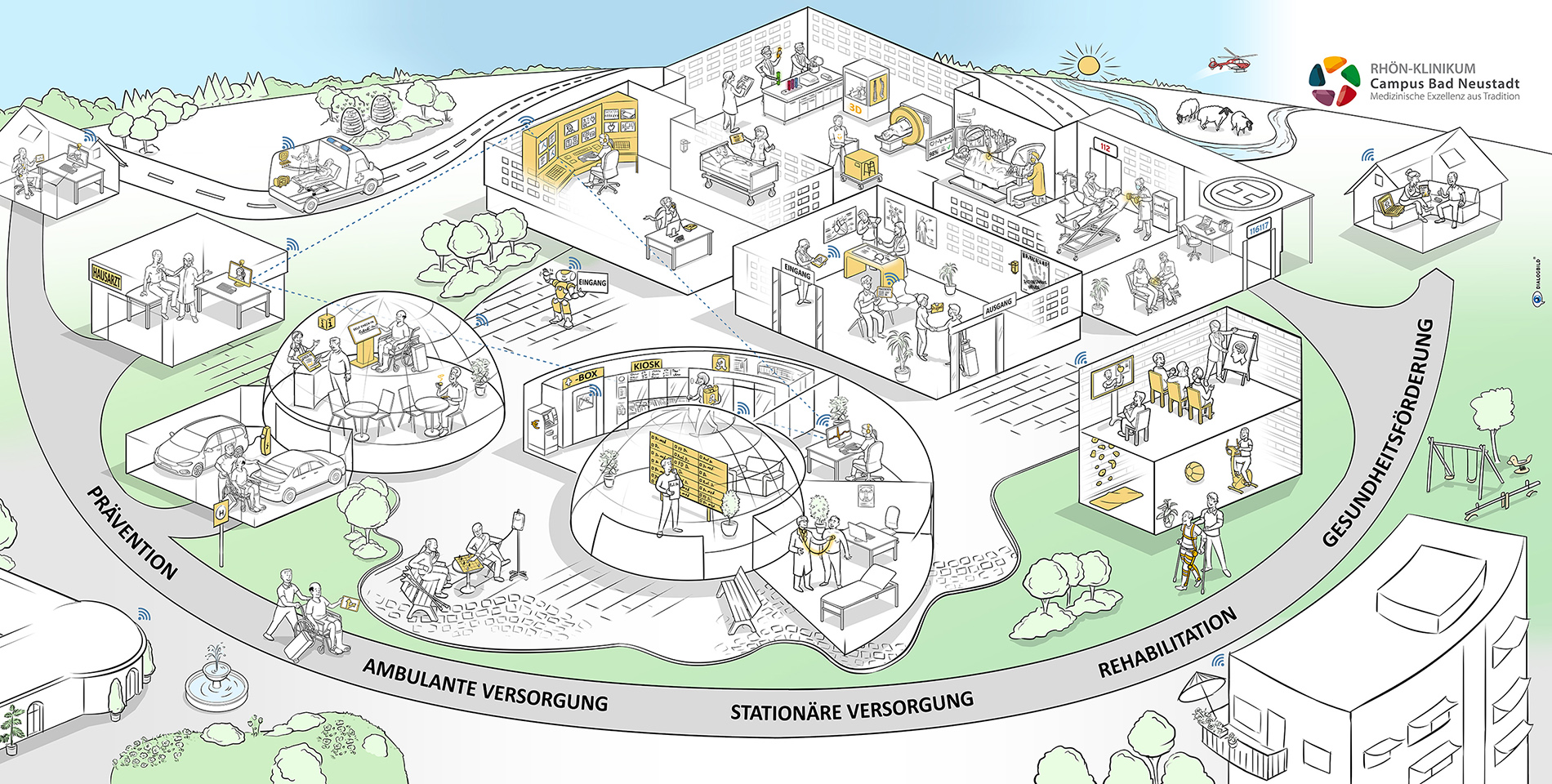
PATIENT & EMPLOYEE COMMUNICATION
VISUALIZED RHÖN CAMPUS CONCEPT AT RHÖN-KLINIKUM CAMPUS BAD NEUSTADT A.D. SAALE
RHÖN-KLINIKUM AG is a listed hospital company. The management of the company is performed by the management board. Three members share the responsibility of the management. The Chairman of the Management Board is Stephan Holzinger, the Chief Operating Officer is Dr. Ing. Gunther K. Weiß and Medical Director is Prof. Dr. med. Bernd Griewing. In total, RHÖN-KLINIKUM AG has five clinic locations in Bad Neustadt a. d. Saale (Bavaria), in Giessen and in Marburg (Hesse), in Bad Berka (Thuringia) as well as in Frankfurt (Oder) (Brandenburg). For this purpose, about half a dozen medical care center companies are managed, which are settled at the various hospital sites.
The RHÖN-KLINIKUM has about 16,700 employees. In order to ensure medical care for everyone, the company pursues a strategy of group-wide direct exchange of knowledge and experience among its employees with the goal of building a close link between medicine and management. The pursuit of the continuous improvement process causes RHÖN to constantly develop and establish new and innovative projects.
...
Frequently asked questions (FAQ) on the clinical pathway
1. What is a clinical care pathway?
A clinical care pathway is a structured plan that maps a patient's entire treatment process from diagnosis to discharge. It is based on medical guidelines and describes the sequence of actions, responsibilities, and timelines to ensure efficient, high-quality care.
2. What is the definition of a care pathway?
A care pathway is a standardized description of processes and procedures in patient care. It specifies which diagnostic, therapeutic, and nursing measures should be performed and in which order to ensure optimal treatment.
3. What are the benefits of a clinical care pathway?
A clinical care pathway offers numerous advantages:
- Improved quality of care through standardized processes
- More efficient use of resources
- Transparency for patients and medical staff
- Reduction of errors and risks
- Reduction in hospital length of stay
4. What are visual care pathways?
Visual care pathways are graphic representations of a clinical treatment pathway. They clearly show the course of treatment on a timeline and facilitate communication between patients, physicians, and nursing staff.
5. Why are visual care pathways useful?
- Visual care pathways offer the following advantages:
- For new employees: Faster onboarding thanks to clear visualizations.
- For patients: Better understanding of the treatment process and reduced anxiety.
- For the team: Improved coordination between all involved.
- For efficiency: Optimized processes lead to faster recoveries.
6. How does DIALOGBILD support the creation of visual treatment pathways?
The DIALOGBILD agency creates customized visual treatment pathways tailored to your specific needs. With an extensive image database, rapid implementation, and cross-media usability, DIALOGBILD offers professional solutions for a clear representation of your processes.
7. How is a clinical treatment pathway created?
Creating a clinical treatment pathway involves several steps:
- Analysis of existing processes.
- Involvement of all stakeholders (doctors, nurses, therapists).
- Integration of current guidelines and standards.
- Definition of quality objectives.
- Training of staff in the application of the pathway.
- Regular evaluation and adaptation.
8. What challenges are there in implementing a care pathway?
The most common challenges include:
- Time required to create and maintain the pathway.
- Lack of digital infrastructure in hospitals.
- Acceptance problems among staff, who may feel their autonomy is restricted.
- Complexity in standardizing individual treatment processes.
9. How do patients benefit from a clinical care pathway?
Patients benefit from:
- Transparency throughout the entire treatment process.
- Consistent and quality-assured care.
- Reduced uncertainty and anxiety.
- Fast recovery through optimized processes.
10. Can visual care pathways also be used digitally?
Yes, visual care pathways can be used both in print and digital formats. They can be integrated into hospital information systems, for example, or used for consultations on tablets or screens.
11. How often should clinical care pathways be updated?
Clinical care pathways should be regularly evaluated and adapted to new medical guidelines or changing conditions to ensure their effectiveness.
12. Are clinical care pathways suitable for all medical conditions?
Clinical care pathways are particularly suitable for common medical conditions with clearly defined treatment processes (e.g., heart attack, stroke, or knee replacement). However, their use is limited for rare or complex cases.
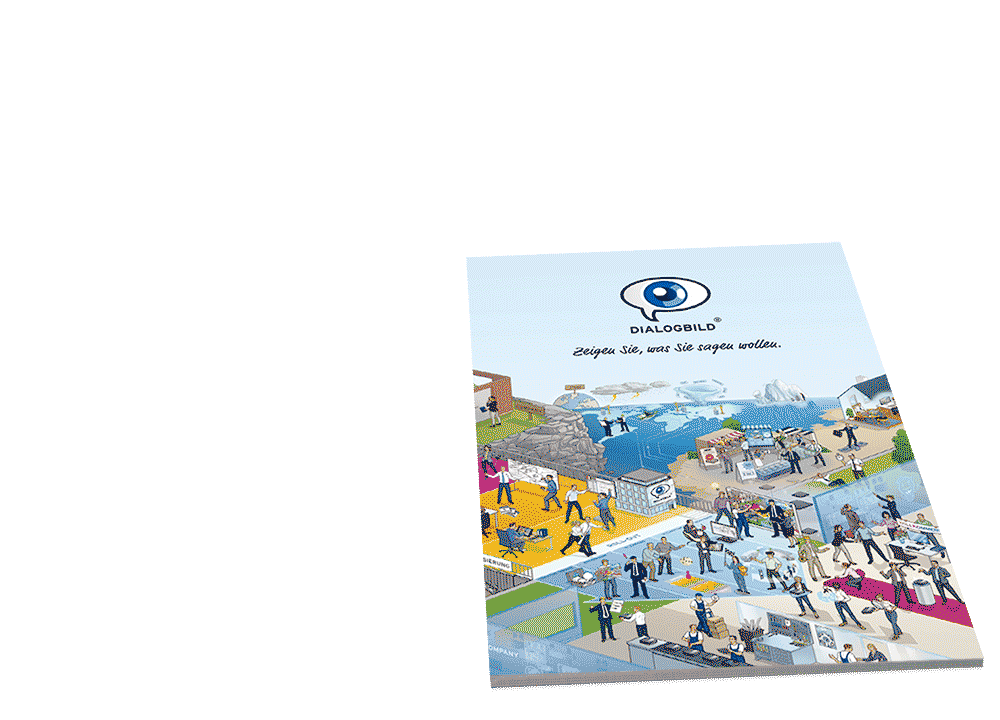 SELECT INFO PACKAGE
SELECT INFO PACKAGE